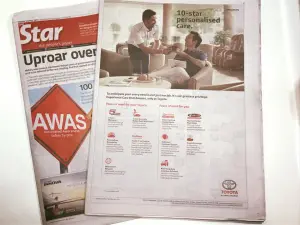I started in the Marketing, Advertising, Public Relations scene as a talent in my teens. Earning pocket money and gaining popularity and recognition in the Malaysian market made great sense. Throughout my college, university, and professional years in between my life tasks and responsibilities, I did freelance gigs as a talent. It's great fun and a good way to make money and show some face to the world out there. But of course these days we got social media.


If you yourself, or know of someone whom you see as a possible fit in some advertisements out there, here are some of my tips from my experience in the Malaysian market as an advertising talent.
Becoming an advertising model is a competitive field, but with dedication and the right approach, you can increase your chances of success. Here are ten tips to help you get started:
Build a Portfolio: Start by creating a professional portfolio that showcases your versatility and range as a model. Include high-quality photographs that highlight your best features and different looks.
Find a Reputable Agency: Research and connect with reputable modeling agencies in your area. Look for agencies that have a track record of working with advertising clients.
Online Presence: Create an online presence by setting up a website or social media profiles (such as Instagram or a modeling-specific platform like Model Mayhem). Regularly update your profiles with new photos and engage with your audience.
Networking: Attend industry events, fashion shows, and open calls to network with industry professionals, including agents, photographers, and casting directors.
Maintain a Healthy Lifestyle: Keep yourself in top physical condition by maintaining a healthy diet and fitness regimen. Models are expected to be in excellent shape.
Practice Posing and Expression: Work on your posing and facial expressions to convey a range of emotions and moods. A good model can convey the desired message for a specific advertisement.

If you get selected, then off to production shoot you go! So now you know how to be an advertising model. Here are some of the video ads I've starred in.
How a TV advertisement production works
TV advertisement production is a complex process that involves several stages. Here's an overview of how it typically works:
Pre-Production:
Concept Development: The process begins with brainstorming and developing the creative concept for the ad. This involves defining the message, target audience, and the overall style and tone of the commercial.
Scriptwriting: Once the concept is finalized, a script is written, outlining the dialogue, scenes, and actions to be captured in the ad.
Storyboarding: Storyboards or visual representations of each scene are created to plan the visual aspects of the ad.
Casting and Auditions:
Professional actors or talent are cast for the commercial based on the script's requirements. Auditions and casting calls may be held to select the right talent.
Location Scouting:
The production team scouts for suitable locations where the ad will be filmed. This includes considering factors like aesthetics, logistics, and permits.
Crew Hiring:
A production team is assembled, including a director, cinematographer, sound engineer, lighting crew, makeup artists, and more. The size of the crew depends on the ad's complexity.
Production Schedule:
A detailed production schedule is created, outlining shooting days, locations, and the sequence of scenes.
Production:
Filming takes place according to the production schedule. The crew captures the scenes, ensuring that the actors perform as per the script and director's instructions.
Post-Production:
Video Editing: The raw footage is edited to create the final ad. This includes selecting the best takes, adding visual effects, and fine-tuning the video.
Sound Editing: Audio elements, including voiceovers, music, and sound effects, are edited and mixed to create a polished sound for the ad.
Color Grading: The color and overall visual style of the ad are adjusted during color grading to achieve the desired look.
Music and Licensing:
If music is used in the ad, the production team secures the necessary licensing rights to use the music legally.
Review and Approval:
The final ad is reviewed and approved by the client, agency, and relevant stakeholders to ensure it aligns with the campaign's goals.
Delivery:
The completed ad is delivered in the required format (e.g., HD, 4K) to TV stations, networks, or other platforms for broadcasting.
Media Buying:
Media buyers negotiate and purchase advertising slots on TV networks or stations to ensure the ad reaches the target audience. The timing and frequency of the ad's airing are strategically planned.
Airing and Tracking:
The ad is broadcast on TV, and its performance is tracked through metrics like viewership, engagement, and sales. Adjustments may be made based on these results.
TV advertisement production can involve large budgets and coordination of various professionals and resources. Effective collaboration among the creative team, production crew, and client is key to producing a successful TV ad that resonates with the intended audience.









